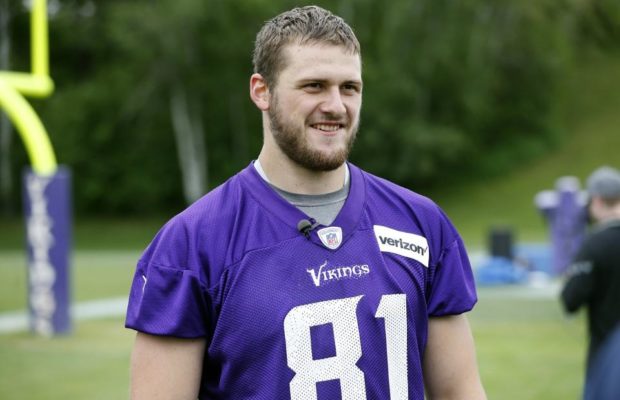Moritz Böhringer Signed To Futures Contract By Minnesota Vikings

It looks like the Minnesota Vikings like what they have seen in German receiver Mortiz Böhringer during the 2016 season as they have signed him to a futures contract.
Even though the 6’4″, 230 lb receiver who wowed NFL scouts and everyone else else at the Florida Atlantic Pro Day and was historically drafted in the 6th round of the NFL Draft in 2016, was relegated to the practice squad, the Vikings obviously still like him.
NFL teams typically use futures contracts to claim the rights to players they think will be able to make some noise in the upcoming season. Clearly, Minnesota believes Böhringer will do just that in 2017.
According to Chris Tomasson of the Pioneer Press Böhringer believes he made strides as a rookie:
“Just overall as a player, improving everything, especially catching, running routes,” he said. “I want to build on the experience I gained throughout the year.”
Böhringer also said he mostly will remain in Minnesota to train before spring workouts begin in April. He said he “definitely” hopes to be on the 53-man roster next season.
The eight other members of the practice squad were also signed to futures contracts.
So what’s a Futures Contract?
It’s the same as a regular active-roster contract, with the regular rules for minimum veteran salaries, cap charges, signing bonuses, etc. The only difference is that it doesn’t take effect until the start of the next League Year (this year, that’s March 9).
Teams can sign players to futures contracts as soon as the previous regular season is over, but the contract won’t count against the salary cap or 53-man limit. Instead, it’ll count against the salary cap and 90-man camp limit of the following season.
In the meantime, the player goes on the reserve/futures list and can’t be signed by any other team.
Who’s Eligible for a Futures Contract?
Any player who wasn’t on an active roster at the end of the outgoing regular season. So, if a player was an unrestricted free agent or on any team’s practice squad, after Week 17, they can be signed to a futures contract.
Here’s the rub of the futures contract: For the most part, they’re used on players who weren’t quite good enough to justify an active roster spot this season but who teams think just might be worth an active roster spot next season. In many cases, this means teams locking up players currently on their own practice squad or another team’s.
This is a great way of locking up talented young guys on the cusp of breaking out.
Since practice-squad players can be poached by any team willing to sign them to an active contract, a futures deal ensures they’ll be in the fold once OTAs and training camp roll around—peace of mind for front offices that would rather be concentrating on keeping its top talent and wooing key veterans at the start of free agency, not scrapping over players who may not make the team.
There’s no limit to how many futures contracts a team can sign, as long as it will be under the 90-man roster cap at the beginning of the league year.
Technically, an unrestricted free agent like Terrell Owens would be eligible for a futures contract, but he’d be unlikely to agree to one.
What are Futures Contracts Worth?
Typically, futures contracts are minimum-salary deals with little or no signing bonus. Most players signed to futures contracts will be fighting for a spot in camp; teams aren’t going to invest much into players who may well be cut the following autumn.